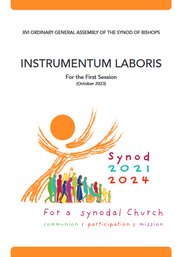
Catholics for Renewal
Subtitle
Editorial July 2023
Instrumentum Laboris: hopes and fears

The Second Vatican Council rescued the church from post-Reformation institutional defensiveness and its triumphalist isolation from the modern world by redefining it as the People of God. As a people, its mission was to be the sign of God’s saving action in human history. This was to be shown but by its critical companionship with the world The People of God exercises its mission to preach the Gospel of Christ by reading ‘the signs of the times’ (Gaudium et Spes 4), and by discerning their meaning synodally.
Fundamental sign: change in concept of reality
The most fundamental sign discerned by Vatican II was a
change in the world’s concept of reality itself:
Thus, the human race has passed
from a rather static concept of reality to a more dynamic, evolutionary one. In
consequence, there has arisen a new series of problems, a series as important
as can be, calling for new efforts of analysis and synthesis (GS 5).
The same document provided a fresh vision to the Church’s
mission by its very first words: ‘The
joys and the hopes, the griefs and anxieties of the people of this age,
especially those who are poor or in any way afflicted, these too are the joys
and the hopes, the griefs and anxieties of the followers of Christ’ (GS 1).
Ironically, by teaching members what they might legitimately expect of their church, Vatican II sensitised them to the pain that would be caused by the disappointment of those expectations. Institutional inertia and deliberate resistance often combined to restrict reform to fit – or at least not to fatally wound – pre-Vatican II paradigms of the right order of things. This combination has induced continuing institutional paralysis in the face of more recent internal and external crises or signs of the times.
The most serious internal crisis faced by the church in centuries is the clerical child sexual abuse one, which – despite initial claims that it was confined to the English-speaking world – has now been shown to disgrace the church worldwide. Shepherds abuse their lambs, and their chief shepherds first cover it up and expose the lambs to further abuse, and now use egregious legal strategies to deny just compensation.
The external crises are posed by climate change, and its disproportionate effects on the poor, persistence in violent solutions to political problems, some of them arising out of religious, racial and ethnic divisions, an economic system that hideously favours the rich over the poor, discrimination against particular groups on sexual/gender grounds, and the persistence of patriarchal structures in human institutions.
Towards a synodal church
Pope Francis’s response to these crises has been to lead us
towards a synodal church. Explicitly inspired by the vision of Vatican
II, a synodal church is one in which all the baptised – hierarchy and laity –
walk together through human history alongside their fellow human beings. Their
unity is the effect of the Spirit at work within them, forming them into a
communion. The truth into which the Spirit guides them concerns their mission
of preaching the gospel to the world by loving service and accompaniment. Their
consciousness of their identity as communion united in this mission
dictates the way in which they are to organise themselves to that end: their
modes of participation.
As a first step towards a synodal church, Pope Francis asked
the church to answer a simple question: ‘What do you think the Spirit is asking
of us now?’ He authorised a worldwide process aimed at involving the people of
God as a whole in a prayerful reflection and dialogue to determine their
answers.
Instrumentum Laboris
The results of these dialogues have now been collated in a working document or Instrumentum Laboris (IL). This document is to be used as a program for the Synod on Synodality, a synodal summit – in which some lay people as well as bishops will have a vote – in Rome in October 2023 and 2024.
The Pope trusts that the church will learn what it means to be a synodal church by an exercise that requires it to engage in a synodal way with each other rather than by a theological debate decided by majority vote. The IL reflects this attempt at a synodal way of being church. By carrying this effort on to the Synod on Synodality, the IL offers hope that the recrudescent triumphalist hierarchicalism repudiated by Vatican II has been abandoned and the Council’s collegial vision developed in theory and in practice into the synodal church envisaged by the IL.
Wisely, the IL accepts Vatican II’s acknowledgement of the church’s immersion in the human condition: a people that is acutely aware of its imperfection and that its completeness or perfection lies in the future: at the end of its redemptive pilgrimage through history (IL 49,50). Though committed to overcoming them, therefore, a synodal communion will not be dismayed by resistance to its efforts at synodality.
Less wisely, the IL contrasts the Ignatian discernment method of policy determination characteristic of the synodal church with parliamentary methods characteristic of political communities. This contrast smacks too much of the transcendence of the human condition claimed by the superseded triumphalist vision of church.
Discovery of communion
The discovery of communion with one another through the Synod’s exercise of the Ignatian method will doubtless induce a certain euphoria: a sense of being church. The danger is that – wittingly or unwittingly – this sense of being church will blunt sensitivity to the urgency of doing things like making decisions about issues arising from the abovementioned crises.
It would be scandalous for the Synod to degenerate into a demonstration that the church is good at endlessly talking about important issues while doing nothing about them.